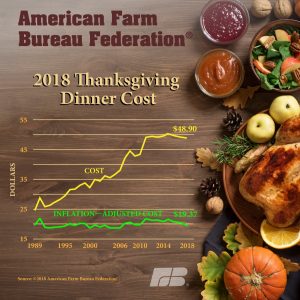 This Thanksgiving, if there is anything for which to be thankful, it is the magic of American markets. Nowhere is this more evident than the recent announcement by the American Farm Bureau Federation that the average cost for a Thanksgiving dinner is at its lowest since 2010.
This Thanksgiving, if there is anything for which to be thankful, it is the magic of American markets. Nowhere is this more evident than the recent announcement by the American Farm Bureau Federation that the average cost for a Thanksgiving dinner is at its lowest since 2010.
In the press release of the 33rd annual survey of typical Thanksgiving foods, the typical feast for 10 (obviously, they are not shopping at Whole Foods) is $48.90, a 22-cent decline from last year. Farm Bureau economist John Newton attributes the low cost to turkey supply:
“Thanks to an ample supply, turkey remains affordable for consumers, which helps keep the overall cost of the dinner reasonably priced as well.”
And let’s not forget the supply channels that enable us to simply show up to a King Soopers, Safeway or Whole Foods and pick up a turkey, as American Enterprise Institute scholar Mark Perry reminds us:
“Like in previous years, most of you probably didn’t call your local supermarket ahead of time and order a Thanksgiving turkey this year. Why not? Because you automatically assumed that a turkey would be there when you showed up, and it probably was there when you appeared “unannounced” at your local grocery store and selected your Thanksgiving bird. Or it will be there today or tomorrow when you do your holiday grocery shopping, or when you “skip the trip” to the grocery store and get 2-hour delivery from Amazon Prime Now….”
In America, at least up through today, we are happy that others are willing to trade hard work of raising turkeys, harvesting cranberries, and growing green beans for our money. Forget the acrimonious political climate that we find ourselves in today and let’s celebrate what Ronald Reagan in 1981 called the “magic of the marketplace.”
